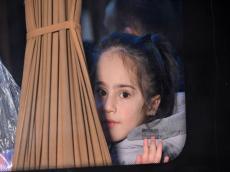|
|
TODAY.AZ / Society
Returning to Jabrayil: former IDPs share their emotional journey home
17 February 2025 [11:19] - TODAY.AZ

On February 18, at sunrise, the neighborhood in the Garadagh district of Baku city, where IDPs uprooted from their homes due to the Armenian invasion during the First Garabagh War settled temporarily, was alive with sounds of joy, excitement, and the tramp of scrambling people.
Once again, the neighborhood was seeing off the group of IDPs, which became a routine since the liberation of the invaded territories in 2020, to their hometowns, Jabrayil. The group was comprised of 42 families or 205 IDPs, most of whom had pulled an all-nighter to leave for their hometown after 30 years. Finally, the separation, which lasted over 30 years, rife with longing for the hometown, is over.
Guluzar Quliyeva, a former IDP who was en route, shared her joy with local media outlets and noted that she would kiss the soil she reaches her hometown. She added that at the age of 34, she was forced to leave Jabrayil under difficult conditions. Now, she is happy to return to her homeland.
"May God bless President Ilham Aliyev, may Allah have mercy on our martyrs, and grant health to our veterans," she said.
Another member of the group returning to Jabrayil was Vugar Verdiyev. He barely remembers Jabrayil, because he was three years old when his family was obliged to depart the district. Now, he has his own family and he is returning to Jabrayil with his kids.
"May God bless our President, have mercy on our martyrs who gave their lives for our lands, and grant health to our veterans.
Our children will also work for the development and prosperity of our homeland," he added.
Like Vugar Verdiyev, Yusif Yusifov also left Jabrayil when he was a child. Yusif said that every corner of Azerbaijan is precious to us, but, like everyone else, our homeland is especially dear to us.
"Living and creating in the land I love, raising our children and nurturing them to become worthy citizens of the country is our primary plan," he added.
It is worth noting that currently, in addition to the displaced people relocated to Karabakh and Eastern Zangazur, over 30,000 people live in this region. These include those working on the implementation of projects in the area, local officials performing their duties in various state institutions, as well as employees in resumed health, education, culture, tourism, industry, and energy enterprises.
URL: http://www.today.az/news/society/257052.html
 Print version
Print version
Connect with us. Get latest news and updates.
See Also
- 19 February 2025 [12:34]
Some 30% of Fuzuli’s internal roads completed as part of Great Return Program - 17 February 2025 [15:14]
ADA and Luiss universities explore new academic programs during delegation visit - 17 February 2025 [11:19]
Returning to Jabrayil: former IDPs share their emotional journey home - 16 February 2025 [16:27]
Caspian Sea's red color explained - 16 February 2025 [14:19]
22 injured, 2 dead in chain collision on Baku-Gazakh highway - 16 February 2025 [13:50]
Flights on Baku-Nakhchivan route resumed following weather improvement - 16 February 2025 [13:34]
State Examination Center to hold multiple exams on February 16 - 13 February 2025 [14:37]
Baku’s ADA University and Partners to host 2025 ICPC World Finals - 13 February 2025 [11:02]
State Agency completes major reconstruction of Keremli Automobile Road - 13 February 2025 [10:15]
Exploring vesugen: cellular aging and metabolism
Most Popular
 Chief of the Armenian General Staff also became blogger
Chief of the Armenian General Staff also became blogger
 Non-Russians of Karabakh as a tool in the information war against Baku
Non-Russians of Karabakh as a tool in the information war against Baku
 Pashinyan takes revenge on his ambassador for the failure in Munich
Pashinyan takes revenge on his ambassador for the failure in Munich
 Samvel Babayan: now the builder of the "opposition front" and at the same time the tender "wizard"
Samvel Babayan: now the builder of the "opposition front" and at the same time the tender "wizard"
 France's phobia of Azerbaijan still puts Macron’s government in a bind
France's phobia of Azerbaijan still puts Macron’s government in a bind
 President Ilham Aliyev reviewed conditions at “Aghdam Residence” residential complex
President Ilham Aliyev reviewed conditions at “Aghdam Residence” residential complex
 President Ilham Aliyev inspects construction progress at nursery-kindergarten No.1 in Aghdam city
President Ilham Aliyev inspects construction progress at nursery-kindergarten No.1 in Aghdam city
